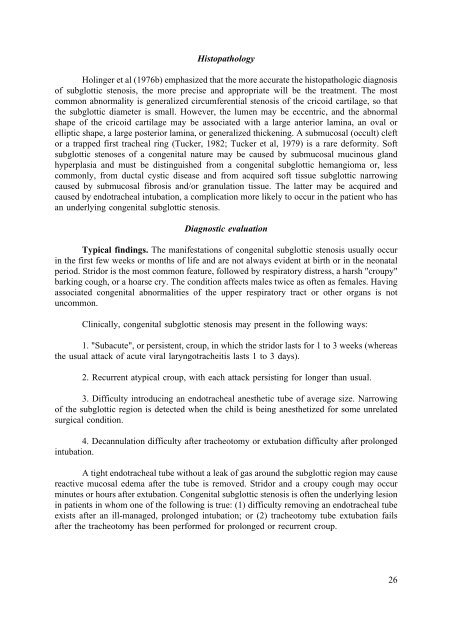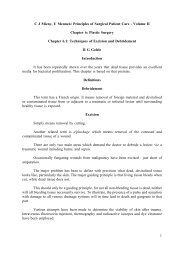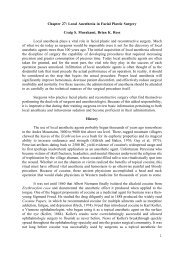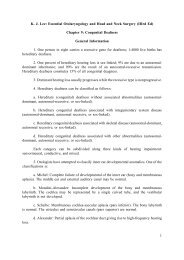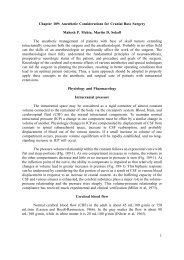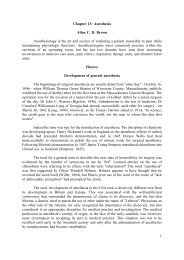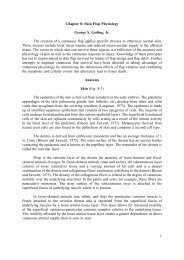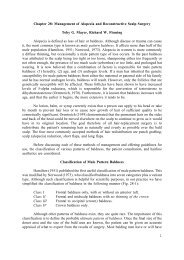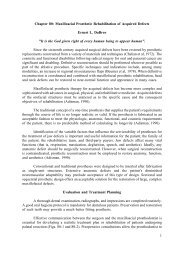1 Chapter 99: Congenital Disorders of the Larynx ... - Famona Site
1 Chapter 99: Congenital Disorders of the Larynx ... - Famona Site
1 Chapter 99: Congenital Disorders of the Larynx ... - Famona Site
Create successful ePaper yourself
Turn your PDF publications into a flip-book with our unique Google optimized e-Paper software.
Histopathology<br />
Holinger et al (1976b) emphasized that <strong>the</strong> more accurate <strong>the</strong> histopathologic diagnosis<br />
<strong>of</strong> subglottic stenosis, <strong>the</strong> more precise and appropriate will be <strong>the</strong> treatment. The most<br />
common abnormality is generalized circumferential stenosis <strong>of</strong> <strong>the</strong> cricoid cartilage, so that<br />
<strong>the</strong> subglottic diameter is small. However, <strong>the</strong> lumen may be eccentric, and <strong>the</strong> abnormal<br />
shape <strong>of</strong> <strong>the</strong> cricoid cartilage may be associated with a large anterior lamina, an oval or<br />
elliptic shape, a large posterior lamina, or generalized thickening. A submucosal (occult) cleft<br />
or a trapped first tracheal ring (Tucker, 1982; Tucker et al, 1979) is a rare deformity. S<strong>of</strong>t<br />
subglottic stenoses <strong>of</strong> a congenital nature may be caused by submucosal mucinous gland<br />
hyperplasia and must be distinguished from a congenital subglottic hemangioma or, less<br />
commonly, from ductal cystic disease and from acquired s<strong>of</strong>t tissue subglottic narrowing<br />
caused by submucosal fibrosis and/or granulation tissue. The latter may be acquired and<br />
caused by endotracheal intubation, a complication more likely to occur in <strong>the</strong> patient who has<br />
an underlying congenital subglottic stenosis.<br />
Diagnostic evaluation<br />
Typical findings. The manifestations <strong>of</strong> congenital subglottic stenosis usually occur<br />
in <strong>the</strong> first few weeks or months <strong>of</strong> life and are not always evident at birth or in <strong>the</strong> neonatal<br />
period. Stridor is <strong>the</strong> most common feature, followed by respiratory distress, a harsh "croupy"<br />
barking cough, or a hoarse cry. The condition affects males twice as <strong>of</strong>ten as females. Having<br />
associated congenital abnormalities <strong>of</strong> <strong>the</strong> upper respiratory tract or o<strong>the</strong>r organs is not<br />
uncommon.<br />
Clinically, congenital subglottic stenosis may present in <strong>the</strong> following ways:<br />
1. "Subacute", or persistent, croup, in which <strong>the</strong> stridor lasts for 1 to 3 weeks (whereas<br />
<strong>the</strong> usual attack <strong>of</strong> acute viral laryngotracheitis lasts 1 to 3 days).<br />
2. Recurrent atypical croup, with each attack persisting for longer than usual.<br />
3. Difficulty introducing an endotracheal anes<strong>the</strong>tic tube <strong>of</strong> average size. Narrowing<br />
<strong>of</strong> <strong>the</strong> subglottic region is detected when <strong>the</strong> child is being anes<strong>the</strong>tized for some unrelated<br />
surgical condition.<br />
4. Decannulation difficulty after tracheotomy or extubation difficulty after prolonged<br />
intubation.<br />
A tight endotracheal tube without a leak <strong>of</strong> gas around <strong>the</strong> subglottic region may cause<br />
reactive mucosal edema after <strong>the</strong> tube is removed. Stridor and a croupy cough may occur<br />
minutes or hours after extubation. <strong>Congenital</strong> subglottic stenosis is <strong>of</strong>ten <strong>the</strong> underlying lesion<br />
in patients in whom one <strong>of</strong> <strong>the</strong> following is true: (1) difficulty removing an endotracheal tube<br />
exists after an ill-managed, prolonged intubation; or (2) tracheotomy tube extubation fails<br />
after <strong>the</strong> tracheotomy has been performed for prolonged or recurrent croup.<br />
26


